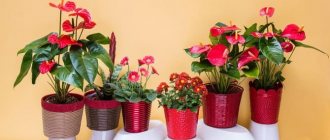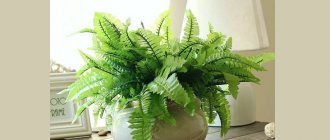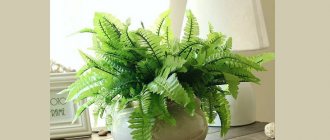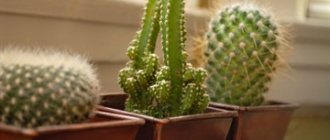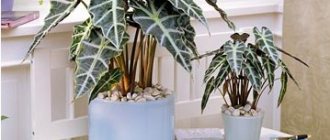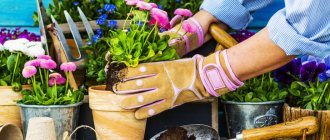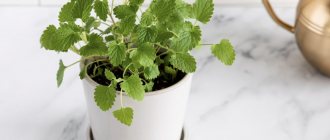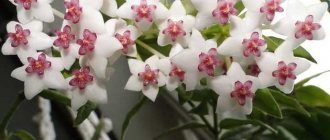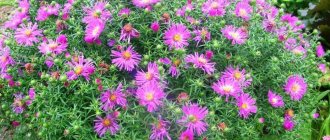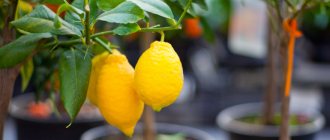Feng Shui
According to ancient Chinese teachings, plants in a house carry special energy, which has a direct effect on its inhabitants.
Lemon
A lemon tree is a symbol of good luck, and a fruit-bearing plant is a sign of abundance and wealth. It increases the thirst for knowledge and activity, so it is especially recommended to keep it in the room where children study and play.
Lemon requires annual replanting, as its root system grows very quickly. Loves diffused lighting, absence of drafts and constantly moist soil.
Crassula or Crassula
Best Flowering Plants
The category of the most capricious, but spectacular and beautiful plants. To maintain decorativeness and form buds, such flowers need a lot of light, fertile soil and timely fertilizing.
Dendratheme
5
★★★★★
editorial assessment
97%
buyers recommend this product
The unpretentious plant is similar to the outdoor chrysanthemum, but blooms all year round and is grown as a potted plant. It is characterized by terry and chamomile-shaped buds, depending on the variety.
Dendrathema needs abundant watering, moderate humidity and an air temperature of +15..+17 degrees. It loves bright places, but also takes root in partial shade, so you can place it anywhere: on a work or coffee table, in the kitchen, north and west windows.
Dendrathema is resistant to pests and diseases, is not demanding on the composition and acidity of the soil, and is easily propagated by popular methods: seeds, dividing the bush and cuttings.
Pros:
- Continuous flowering;
- Easy care;
- Grows in sun and partial shade;
- No need to spray frequently;
- Low-growing and compact bush (15-20 cm tall);
- Easy to propagate;
- Pleasant bitter aroma.
Minuses:
- Does not tolerate heat and drought.
During the growth period, a solution of complex mineral fertilizers is applied under the bush. The procedure is repeated every 2 weeks, but even without fertilizing the plant blooms profusely.
Indoor hydrangea d23 h50
4.9
★★★★★
editorial assessment
92%
buyers recommend this product
The hydrangea bush grows up to 70-100 cm in height, has lush foliage and spherical brushes that bloom from April to November. Basic shades: white, pink and blue. It is believed that the plant carries positive energy, normalizes relationships within the family, extinguishes negativity, relieves stress and fatigue.
It is advisable to place pots at a distance of 1.5-2 m from southern windows. Hydrangea loves bright but diffused light, high humidity (especially on hot days) and frequent watering. Feeding is carried out every 2 weeks with a mineral complex at the root from February to October.
Pros:
- Lush and beautiful inflorescences;
- Blooms continuously throughout the growing season;
- Propagated by cuttings and dividing the bush;
- Infrequent transplantation - every 3-4 years;
- Carries positive energy;
- Loves diffused light - southern and eastern windows are suitable;
- Medium level of cultivation difficulty.
Minuses:
- High humidity and daily spraying are needed, but waterlogging should not be allowed;
- It is difficult to organize wintering at temperatures of +7..+10 degrees.
If wintering conditions are not met, flowering may not occur. The plant becomes very depleted during the growing season and needs a long rest somewhere in the basement or other dark room. Before this, pruning is carried out: young shoots are cut off at the root, old ones - up to half, greens and brushes are removed completely.
Camellia japonica
4.8
★★★★★
editorial assessment
88%
buyers recommend this product
Summer-flowering plants are being replaced by camellia. She blooms buds from December to February, and during this time she needs to provide suitable care: air temperature within 8-12 degrees, regular moderate watering and a well-lit windowsill of a western or southern window.
In summer, camellia is shaded from the sun, sprayed all season, maintaining high humidity. Feed it once every 3 weeks with mineral compounds.
Pros:
- Beautiful pink and peony flowers;
- With proper care and pruning, it branches well, producing many buds and foliage;
- Highly decorative;
- There are ready-made compositions of fertilizers and soil on sale - you don’t need to mix anything yourself;
- Easily propagated by fresh seeds and cuttings.
Minuses:
- Requires balanced lighting;
- The buds fall off when the temperature is violated;
- Susceptible to attack by scale insects and spider mites.
You can grow a healthy camellia only by strictly following the instructions. It reacts sharply to a lack of sun or moisture, and has low resistance to diseases and pests. But if the rules are followed, it presents the owner with a chic bouquet of unusual flowers.
Indoor jasmine polyanthus
4.8
★★★★★
editorial assessment
87%
buyers recommend this product
Indoor jasmine looks more modest. Its flowering is not so expressive, the buds are small, white with five petals. Proper pruning gives the plant the opportunity to branch like a shrub, producing even more flowers. This must be done every season (3-4 times a year), otherwise the vines will stretch out and droop.
The lashes are wrapped around supports of various shapes: rings, hearts, ladders or nets are installed. Indoor jasmine is easy to care for and grows in neutral and acidic soils. Reacts negatively to the presence of lime in soil or water.
Pros:
- Easy to care for;
- Requires only moderate watering and responds well to spraying;
- Easy to propagate by cuttings or root division;
- Blooms thickly;
- Acts as a hanging and bushy crop;
- Grows well in both warm and cool rooms.
Minuses:
- Requires frequent pruning of vines;
- Water for irrigation must be settled and acidified:
- If molded incorrectly, the vines become bare and the flower loses its attractiveness.
The bushes are replanted annually by transferring them into a larger pot, using clay-turf soil. Fertilizing is introduced during the budding period with organic and mineral additives.
Dendrobium Orchid
4.7
★★★★★
editorial assessment
85%
buyers recommend this product
An orchid hybrid with high decorative qualities blooms for 2-3 months and requires intensive care: daily moistening of the substrate, maintaining air humidity at 50-80% and fertilizing every 2 weeks. The plant loves bright rooms, protected from direct sunlight.
Orchids are grown mainly in greenhouses or conservatories, where all conditions are created for them. The hybrid shoots stems up to 1 m high and forms many buds. Propagated by cuttings, aerial roots and root division.
Pros:
- Beautiful flowering;
- Lots of buds and greenery;
- Loves partial shade - can be placed on a table near a window;
- The decorative period is possible throughout the year;
- Reproduces in different ways.
Minuses:
- If agricultural technology is violated, it dies;
- Sensitive to sun and draft.
Dendrobium is quite capricious and difficult to grow. With excessive watering, the roots rot, dry out without water, the plant reacts negatively to the sun and wind, and air humidity must also be maintained. But, if you create all the conditions, a beautiful bouquet of the most delicate flowers awaits you.
READ ALSO
12 best fertilizers
The best ampelous flowers
Hanging plants have always been in demand. They get along well on cabinets, shelves, in flowerpots, and decorate balconies and loggias. With their creeping vines they resemble green waterfalls, but if not properly cared for they lose their decorative properties.
Campanula
5
★★★★★
editorial assessment
97%
buyers recommend this product
People call this flower the Bride and Groom. The herbaceous perennial thrives in the garden and in hanging flowerpots. Its buds bloom into beautiful bright blue or white bells and are covered thickly with vines.
According to the teachings of Feng Shui, the plant creates a favorable, warm environment, fills the house with positive energy and attracts money. Campanula is not fussy to grow. For replanting, universal soil for flowering plants and a small pot are suitable. Water it often, especially in summer.
Pros:
- Bright and dense flowering;
- Looks very impressive in hanging flowerpots;
- Ideal for creating an alpine slide in the garden or wall decoration;
- Does not require maintenance;
- Easily propagated by cuttings and rhizomes;
- Suitable for a novice gardener.
Minuses:
- For irrigation, only soft, settled water is needed;
- The plant needs pruning.
At the end of flowering, the lashes are cut by a third - this will help the plant regain its strength and expel young shoots. Closer to winter, a thorough haircut is carried out, leaving 10-12 cm from the root.
Godson Rowley
4.8
★★★★★
editorial assessment
91%
buyers recommend this product
The culture is a succulent, grows quickly and looks quite extravagant. On thin shoots, spherical leaves resembling peas are formed. Raspberry, like all succulents, easily tolerates drought, partial shade and low humidity - an excellent option for growing on a wall in a hallway, kitchen or hallway (but not with windows facing north). With proper care, the plant blooms, and the peas are the size of green gooseberries.
Pros:
- Unusual appearance;
- Easy to care for;
- Grows well in partial shade;
- Easily tolerates dry air;
- Harmonizes with other succulents;
- Cut stems serve as cuttings for propagation.
Minuses:
- Poisonous culture;
- With frequent changes of residence, it sheds its leaves.
The succulent contains toxic substances in its sap. So if pets or a child try the leaves on their teeth, they will get seriously poisoned.
Scindapsus pictus
4.7
★★★★★
editorial assessment
86%
buyers recommend this product
A vine with asymmetrical leaves and white splashes looks impressive on a wall or flower stand. The length of the vines is 50-100cm. They are densely covered with greenery, hiding the pot. The native of Indonesia is moisture-loving, so you need to monitor the condition of the earthen clod and spray it daily, especially in the summer heat. Every spring the plant is transplanted and molded.
Pros:
- Evergreen densely leafy crop;
- Highly decorative;
- The plant is resistant to diseases and pests;
- Looks harmonious in hanging pots;
- Easily tolerates heat with frequent spraying.
Minuses:
- Requires high humidity;
- The sap is poisonous;
- Does not bloom at home.
The culture loves high-quality lighting: in partial shade it sheds its leaves and loses its unique color - there are fewer light spots. The ideal place for it is a loggia, where it is easiest to maintain sufficient humidity. You can place a container of water next to the pot or pollinate the plant with a spray bottle once a day.
How to choose healthy houseplants
When deciding which indoor plants to choose for your home, first of all, carefully inspect the flowers - they must be healthy.
In flower shops, many plants of different types stand together: large and small, bushy and elongated, with buds and blossoming flowers. Unfortunately, sometimes among them there are also sick species. Therefore, before choosing indoor plants, always carefully inspect the specimens that you are going to buy, take your time.
Plant shape. The plant must have several shoots. Bushy plants should branch well. Pay attention to the shape: the plant should not be one-sided and have bare stems at the base.
Leaves. Buy plants that are well leafy, with strong, healthy leaves and no brown spots, wilted tips, dry or misshapen edges. Look to see how many leaves have already fallen (small scars remain where they are attached to the stems).
Flowers. Decorative flowering species should not have many fully bloomed flowers, but the buds should be numerous and well developed. If the buds are small, poorly developed and are still far from blooming, they sometimes do not bloom at all under new conditions and fall off.
Pests. It is recommended to inspect potted plants for pests. Good advice, but only if every buyer turns, touches the leaves and looks at the roots, what will be left of the plants?
It's time to throw them away. It is best to carefully examine the tips of the shoots: this is where aphids most often sit. Pay attention to suspicious yellow-brown spots on the leaves. But mostly rely on the overall impression a healthy (or diseased) plant gives you.
If you are faced with a dilemma: choose a plant standing inside the store or outside, on the sidewalk, buy the first one, because... many indoor plants suffer from exhaust fumes and street dust.
If you have decided which house flowers are best to choose for your apartment, pay attention to the following parameters:
Cyclamen (Cyclamen persicum) should have straight, strong peduncles and many buds. A healthy tuber is dense, without spots.
Azaleas (Rhododendron) are not worth buying in full bloom. The buds between the leaves should be well developed. The pot needs to be heavy.
Bougainvillea can be purchased when the first bracts are colored.
Bromeliads (Bromeliaceae) with fully bloomed flowers do not live long. Note the brown, cracked tips of the leaves.
Dieffenbachia often loses its lower leaves. Buy only fully leafy plants.
Dragon tree, or dracaena , has different types, each requiring special care. Find out the exact name of the plant.
Ivy (Hedera) is susceptible to pest infestations. Carefully inspect the tips of the shoots and leaves.
Ferns should grow in a dense bush, with strong fronds and new buds.
Impatiens should be purchased as a compact bush with brightly colored leaves, new shoots and many buds.
Rubber ficus (Ficus elastica) , which has a lot of scars on the stems from fallen leaves, is already old or unkempt.
Stephanotis floribunda when the first buds open. Yellow leaves are a sign of nutrient deficiency.
Palm trees are capricious plants. Buy only immaculate-looking palm trees.
Sansevieria should have leaves with sharp edges and perfect tips.
Usambara violets (Saintpaulia ionantha, hybrids) with pale, drooping leaves should not be purchased.
